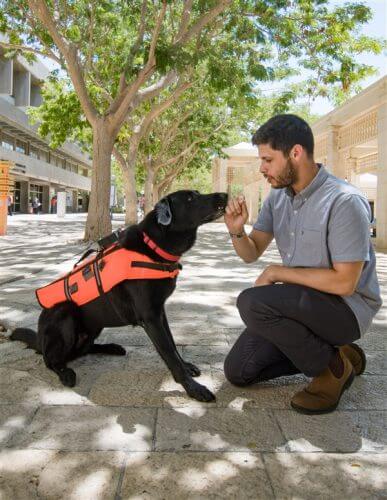Dogs can be trained to respond to vibration commands while wearing a vest developed by a team of interdisciplinary researchers at Ben-Gurion University of the Negev

Dogs can be trained to respond to vibration commands while wearing a vest developed by a team of interdisciplinary researchers at Ben-Gurion University of the Negev. The research was presented at the World Haptics conference on July 12 in Tokyo, Japan. Haptic technology simulates the senses of touch and movement, which is especially helpful in remote operation or computer simulation, where the user is not able to communicate with physical objects directly, but indirectly.
This technology may be useful for remotely commanding search and rescue dogs, assistance dogs for patients with disabilities, and other service dogs.
"The research findings show that dogs responded to vibration cues better than voice commands," said Prof. Amir Shapira, director of the robotics laboratory in the mechanical engineering department at Ben-Gurion University of the Negev. "The current study shows promising results that open the way towards the use of contact technology for communication with dogs."
The vest contains four small vibration motors located on the dog's back and sides, already commercially available. The motors allow dogs to be trained to respond to different types of vibrations sent via a remote wireless control. The trainer can trigger different commands by controlling the area and duration of the vibration. In the simulation video, Ty, a Labrador Retriever/German Shepherd, responds to several different commands such as: "turn around", "down", "to me" and "back".
Combining the vest with the training devices available on the market today may be successful and strengthen the reward system used for training. "Incorporating devices will allow us to promote the potential of partially or fully autonomous dog training to evaluate general behavior, responsiveness to commands and the effectiveness of rewarded dogs for desired behavior" continues Prof. Shapira.
Future studies will test the vest technology in different breeds, ages and training experience and will incorporate more advanced devices in search and rescue dogs, military working dogs and service dogs.
Yoav Golan, a doctoral student in the Department of Mechanical Engineering, and Ben Sarota, who has a master's degree in the Department of Neuroscience, began the research as a summative project in the "Sensing and Perception of Touch" course taught by Dr. Ilana Nisky, a senior lecturer in the Department of Biomedical Engineering, a member of the Zlotovsky Center for Neuroscience and head The laboratory for biomedical robotics. The research team also included Dr. Oren Shariki, head of the laboratory for computational psychiatry in the cognitive and brain sciences department.
The research was supported by the Leona and Harry Helmsley Fund for the ABC Robotics project - research in agricultural, biological and cognitive robotics.
